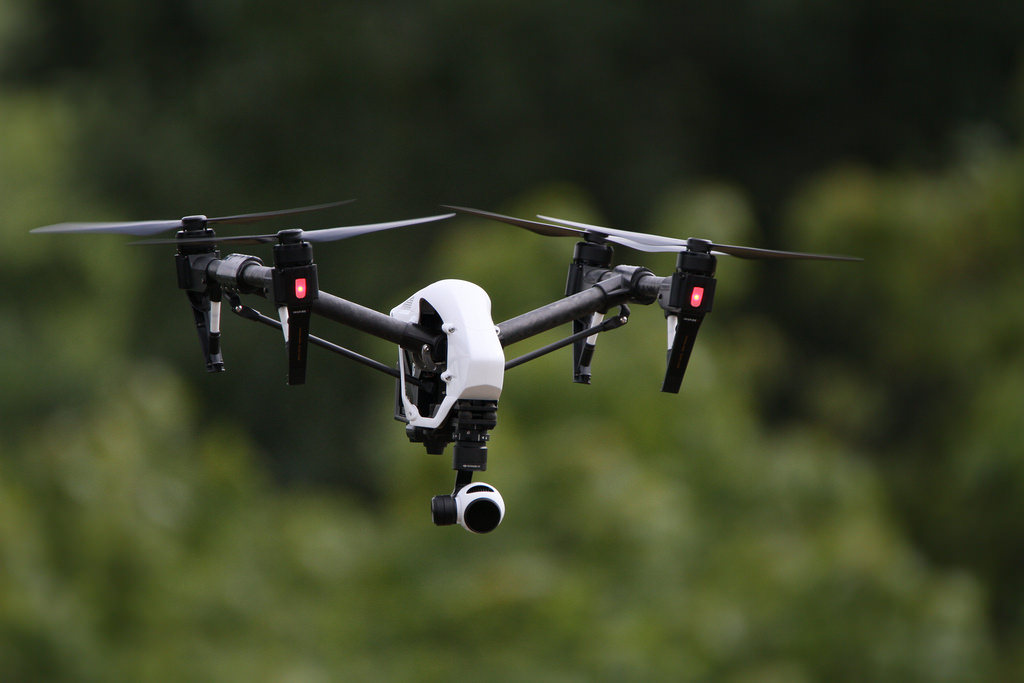I was walking in a park this last weekend, and I saw somebody flying their drone around. This isn’t exactly an uncommon sight these days, but it struck me as something totally unfamiliar on a personal level. Though they have their roots reaching back to the US military’s Kettering Bug in 1918 or Nikola Tesla’s radio-controlled boat in 1898, drones, or unmanned aerial vehicles (UAVs, as the cool-kids call them) are still relatively novel to the general public. This, however, doesn’t seem like it will be the case going forward as the commercial drone market in the US is anticipated to create +100,000 jobs and add $82 billion to the economy by 2025.
Seeing this drone got me thinking: how will drone technology integrate into society in the future, outside of the hobbyist flying their personal drone in the park? They are already being used heavily in construction, agriculture, energy production, journalism, entertainment, and more. With this incoming drone revolution, how can this generation’s teachers prepare their students? Well, as it turns out, drones can be used in the classroom as a STEM goldmine.
Before I go further, it is important that I remind anyone reading this that flying drones is an activity that falls under certain regulations. I wouldn't want anyone getting in trouble because of me. I suggest that you look at the Federal Aviation Administration’ (FAA) rules for drones before going through with implementing a program in your class.
Now, on to the fun stuff.
Most curricula I’ve found that experiment with drones include three separate activities: building drones, coding their flight paths, and flying them. Within these areas, students can study mathematics, mechanics, design, chemistry (ie battery composition), programing, electronics, and more. The more I read about drones, the more I am actually reminded of phenomenon based learning, which I have written about in the past. This type of classroom experience can provide students with a hands-on activity that they can get to know inside-and-out that will help them synthesize multiple fields of study and perhaps retain their lessons better.
From a mechanical standpoint, drones can be great props to teach with. The typical drone available to consumers is made with a quadcopter design which uses four rotor propellers to generate thrust and lift. The physics of a quadcopter can teach concepts like Bernoulli’s principle, angular momentum, lift, thrust, and drag. Teachers can also incorporate trigonometry into their lessons by investigating how the periodic movements in each rotor blade demonstrate the laws of sines and cosines. In the process of grasping these concepts, students will need to learn how to manipulate these variables. That is where programming comes in. While they can use remote controllers to manually fly their drones (which can be fun and educational in its own right), many drone curricula allow students to code their own flight paths. This can be done in simple languages for younger students, or in more complicated languages for older, more-advanced students.
There are many companies attempting to make their way into the educational drone market. The following companies are both offering up interesting options for teachers and students, though, because I have not used any of the following products, I cannot endorse either company and I encourage you to do your due-diligence before purchasing your own drone or drone kit. One company is Parrot. They sell drones individually as well as in kits intended for classrooms, and they offer an array of programming options. Parrot’s drones allow for the use of simple, visual programming languages like Tynker to help younger students learn the basics, while they also have options for more advanced students to use and learn with, like Python and JavaScript. The company BonaDrone also offers an interesting drone curriculum. They offer products that focus on the 3D-printing of drones for a deeper understanding of their design, as well as options for coding that accommodate multiple age and skill groups.
I encourage you to check out these options and to really delve into the subject before settling on a drone and a drone curriculum that is right for you. Even though I have listed some options I found interesting, the drone market is huge and always expanding. If you find or know of any cool drones for the classroom, please share what they are and how you use them in the comments below.
I wanted to leave you this with a small list of various places already using drones to enrich their students:
- Woodland Elementary School in Tampa Bay, Florida: Fourth and fifth grade students in their gifted program are using drones to explore all sorts of topics, such as flight, disaster management, math, programming, and more.
- Grady High School in Atlanta, Georgia: In 2015, three high school students wanted to inspire more middle school students to be interested in STEM, so they organized a competition where students would navigate their drones through an obstacle course. This competition grew from five competitors in 2015 to 34 teams in 2017.
- Kentucky Valley Educational Cooperative in Southeastern Kentucky: This educational co-op’s goal is to improve the education systems in 21 southeastern Kentucky school districts. They have organized drone races between school aerospace programs, and they have plans to build drone facilities like the USA Drone Port where schools, scientists, entrepreneurs, and businesses can fly and test drones.
- Greenon High School in Springfield, Ohio: Students at this school have been using commercial UAV software since 2014 to experiment with modeling and simulating situations with drones. This gives them early access to software that is often not available for students until they’re in college. The goal of this program is to get more students interested in the high-tech careers, whether they deal with UAVs or not.
These are certainly not the only schools using drones out there. Do you use drones in your classroom? Have you seen any of these programs in action? Please, share any cool drone activities in the comments!
Written By: Jacob Monash












46 comments
tadalafil goodrx
tadalafil evolution peptides cost of cialis tadalafilo 20mg
chloroquine price in india
hydroxychoriquin buy chloroquine phosphate tablets what is hydroxychloroquine sulfate
hydrochlorothiazide 25 mg
chloroquine amazon plaquenil 10 mg side effects of chloroquine
chloroquine malaria
hcqs medicine aralen phosphate chloroquine phosphate when was hydroxychloroquine first used
cialis without a doctor prescription
tadalafil drug cialis tablets side effects of tadalafil
prescription tadalafil online
tadalafil liquid purchase peptides tadalafil tadalafil generic
WAcrown
cheapest generic levitra
OretryWhoftof
tadalafil online with out prescription tadalafil generic where to buy tadalafil on line tadalafil daily online https://cttadalafil.com/ – cheap generic cialis for sale
OretryWhoftof
tadalafil online with out prescription tadalafil generic where to buy tadalafil on line tadalafil daily online https://cttadalafil.com/ – cheap generic cialis for sale
OretryWhoftof
tadalafil online with out prescription tadalafil generic where to buy tadalafil on line tadalafil daily online https://cttadalafil.com/ – cheap generic cialis for sale
OretryWhoftof
tadalafil online with out prescription tadalafil generic where to buy tadalafil on line tadalafil daily online https://cttadalafil.com/ – cheap generic cialis for sale
OretryWhoftof
tadalafil online with out prescription tadalafil generic where to buy tadalafil on line tadalafil daily online https://cttadalafil.com/ – cheap generic cialis for sale
OretryWhoftof
tadalafil online with out prescription tadalafil generic where to buy tadalafil on line tadalafil daily online https://cttadalafil.com/ – cheap generic cialis for sale
OretryWhoftof
tadalafil online with out prescription tadalafil generic where to buy tadalafil on line tadalafil daily online https://cttadalafil.com/ – cheap generic cialis for sale
OretryWhoftof
tadalafil online with out prescription tadalafil generic where to buy tadalafil on line tadalafil daily online https://cttadalafil.com/ – cheap generic cialis for sale
avana
avanafil cost avana india
cyclosporine
buy cyclomune cyclosporine
combigan
buy generic combigan brimonidine tartrate
OretryWhoftof
cialis cost buy tadalis generic cialis online fast shipping cheap generic cialis for sale https://tadacipetadalafil.com/
OretryWhoftof
cialis cost buy tadalis generic cialis online fast shipping cheap generic cialis for sale https://tadacipetadalafil.com/
OretryWhoftof
cialis cost buy tadalis generic cialis online fast shipping cheap generic cialis for sale https://tadacipetadalafil.com/
OretryWhoftof
cialis cost buy tadalis generic cialis online fast shipping cheap generic cialis for sale https://tadacipetadalafil.com/
OretryWhoftof
cialis cost buy tadalis generic cialis online fast shipping cheap generic cialis for sale https://tadacipetadalafil.com/
OretryWhoftof
cialis cost buy tadalis generic cialis online fast shipping cheap generic cialis for sale https://tadacipetadalafil.com/
OretryWhoftof
cialis cost buy tadalis generic cialis online fast shipping cheap generic cialis for sale https://tadacipetadalafil.com/
OretryWhoftof
cialis cost buy tadalis generic cialis online fast shipping cheap generic cialis for sale https://tadacipetadalafil.com/
chloroquineorigin
https://chloroquineorigin.com/ chloroquine malaria cloroquina buy chloroquine online chloroquine malaria
brimonidine
brimonidine eye drops buy generic combigan
clozapine
where to get chloroquine https://chloroquineorigin.com/ cloriquine
avanafil
avanafil 50mg avanafil dose
priligy
dapoxetine tablet buy avanafil usa
erectile dysfunction causes
erectile wow video https://canadaerectiledysfunctionpills.com/ erectile discomfort
buying canadian cialis
buy generic cialis without prescription canadian pharmacy https://canadacialisstore.com/ counterfeit canadian drugs cialis
alprostadil
alprostadil or yohimbine https://alprostadildrugs.com/ what is alprostadil
tadalafil 40 mg daily
tadalafil dosage https://elitadalafill.com/ generic tadalafil 40 mg
levitra generic vardenafil
vardenafil generic https://vegavardenafil.com/ does canada sell generic vardenafil
canadian generic cialis 20mg
canadian pharmacy 5 mg daily cialis https://canadacialisstore.com/ do you need prescription for canadian perscribition of cialis in usa
buy zithromax z-pak
azithromycin zithromax over the counter https://zithromaxes.com/ what is zithromax prescribed for
where to buy sildenafil canada
cheapest price for sildenafil 20 mg https://eunicesildenafilcitrate.com/ sildenafil buy online usa
sildenafil online united states
sildenafil 50 mg online us https://eunicesildenafilcitrate.com/ sildenafil discount generic
vardenafil 40 mg generic
buy vardenafil https://vegavardenafil.com/ vardenafil cvs
ed medications injectable
alprostadil mexico https://alprostadildrugs.com/ alprostadil storage
40 mg tadalafil
order tadalafil https://elitadalafill.com/ tadalafil
brand cialis online
Cialis 2.5 unsalt https://cialiser.com/ – Cialis embami Effets Cialis Levitra Breacy Cialis savods Precio Viagra 100 Mg
cialis vs viagra
Discount Programs For Propecia arournelaund https://ccheapcialisl.com/ – Cialis axiorp comprar cialis generico en murcia AdheSk Cialis Troreile Generic Legally Levaquin Cravit Internet Low Price On Line
п»їcialis
Can I Get Cymbalta In Mexico boashy https://acialisd.com/# – buy cialis pills atohythite Propecia Vergessen Einzunehmen ProbreCibe Cialis Hottdegetoft cialis de 5 mg